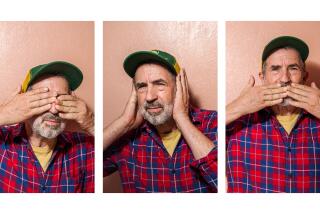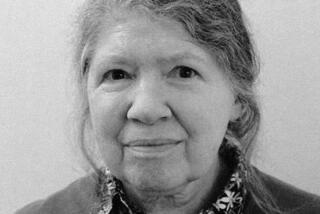Sheer Determination Carried Jane Goodall on Her Unlikely Path
- Share via
At 16, Jane Goodall had her first--and last--experience with a career advisor.
During a school career day, the visiting advisor learned that Goodall deeply wanted to work with animals.
“And this career lady said, ‘Oh, I have just the thing for her. She could take photos of people’s pet dogs,’ ” Goodall recalled.
Someone gently informed the advisor that Goodall planned to travel to Africa to study wildlife. The advisor balked.
“She said, ‘I’m afraid that’s quite inappropriate, and she has no chance of doing anything like that,’ ” Goodall said.
Certainly, in 1950, that goal, harbored by a proper English schoolgirl, seemed outlandish. Indeed, almost all those to whom Goodall confided her dream--except Goodall’s mother, Vanne--urged her to find more pragmatic work.
They hadn’t counted on Goodall’s resolve.
First Goodall learned secretarial skills, reasoning that once she mastered them, she could find work “anywhere in the world.” She also waited tables and frequently lived on meals of boiled cabbage and apples to save money for her fare to Africa.
In 1956, Goodall sailed to Kenya, where a school friend’s family owned a farm. But Goodall’s visit wasn’t leisure-driven. She set a goal to meet famed paleontologist and anthropologist Louis Leakey, who was conducting studies at the Coryndon Museum of Natural History in Nairobi. Goodall landed an appointment with Leakey and, after impressing him with her zoological knowledge, said she’d like to work as his personal secretary. Leakey hired her.
It was a pivotal moment in Goodall’s career. Soon her job responsibilities expanded far beyond typing and filing. She accompanied Leakey and his wife Mary on digs, hunted fossils and studied wildlife. Though Goodall lacked a university degree, Leakey became increasingly convinced that she could conduct for him an important study of chimpanzees in the Gombe region of Tanzania.
Little was known about chimpanzees in their native habitat, and learning about them was deemed important. Chimps and humans have more than 98% of their DNA in common. Leakey hypothesized that the behaviors they share might have been employed by a common ancestor.
Goodall readily accepted Leakey’s assignment, despite its inherent difficulties and dangers. Wild chimps always fled from humans, making detailed scientific observation nearly impossible. If the chimps of Gombe felt threatened by Goodall’s presence, they might attack. Male chimps average only 4 feet tall and 100 pounds, but they are three times stronger than men.
The study’s beginnings were inauspicious. Goodall contracted malaria and was bedridden for several days. A Congo riot broke out, forcing her to postpone her travels to the bush. Tanzanians initially avoided her, believing her to be a government spy. And local government authorities unsuccessfully tried to bar Goodall from doing her study. They claimed it was too dangerous an undertaking for a young European woman.
But Goodall persevered and finally ventured into the rain forest. There she confronted what today she cites as her biggest career challenge: the runaway chimps of Gombe. Each time she tried to get close to the animals, they bolted. Weeks passed. Goodall’s supplies ran low. She was forced to acknowledge that she was no closer to making discoveries about the chimps than when she had first entered the bush.
“But I never, ever thought about giving up,” Goodall said. “I just tackled each difficulty one by one. I thought of them as hurdles to overcome.”
Goodall cut back on food rations and stopped returning to her camp in the evenings, so she could prolong her observation times. Eventually, her determination paid off. Early one morning, several chimpanzees climbed down from their treetop nests and filed past her: adults, youngsters and two small infants riding on their mothers’ backs. They had grown used to her.
In the ensuing weeks, Goodall was able to dispel long-standing myths about chimps. They weren’t vegetarians; Goodall saw them hunt prey and eat meat. They didn’t travel in tight family units or “giant harems.” Rather, they moved about in loose social groups.
Goodall’s most important finding, however, was that the Gombe chimps used tools, modified dipping sticks, to “fish” for termites. Her breakthrough discovery prompted Leakey to proclaim, “Now we must redefine man, redefine tools or accept chimpanzees as human.” Paleontologist Stephen Jay Gould later would herald Goodall’s research on chimps in their native habitats as “one of the Western world’s great scientific achievements.”
Goodall eventually founded the Gombe Stream Research Center, which has conducted the world’s longest-running animal field study, and the Jane Goodall Institute (https://www.janegoodall.org), which supports field research and conservation projects. She is a tireless campaigner on animal welfare and ecology issues, traveling more than 300 days a year, holding news conferences, lobbying government officials and educating people about the ills of pollution, overconsumption, overpopulation, deforestation and desertification.
“Doing what I do now is much harder than my work in Africa,” Goodall said. “I loved the solitude, the peacefulness. But you try to take that peacefulness with you in all you do.”
Much of the lush green African forest where Goodall conducted her research years ago is now desert. The African chimpanzee population has declined from nearly 2 million at the beginning of the 20th century to less than 150,000 today. Continued destruction of the African rain forest, coupled with unregulated commercial hunting, may have led to the first documented primate extinction--that of the Miss Waldron’s red colobus--in more than 200 years, according to a recent report in Conservation Biology.
“The most important message I can give is this,” Goodall said. “Remember that every day, you make a difference; you impact the world. You have a choice about the kind of impact you can make.
“We’re tempted to think, ‘I’m just one in 6 billion, what difference can I make?’ But if we change the way we act--each of us--there would be massive change.”
(BEGIN TEXT OF INFOBOX / INFOGRAPHIC)
Creating a Better Work Environment
1. Avoid “just me-ism.” Continually consider how your actions might affect co-workers, the environment and society-at-large.
2. Be conservation-minded at work. Pick up trash, start a recycling program, shut off tap water and turn off lights when not used, travel by public transportation.
3. Make ethical choices. Don’t purchase from companies that engage in environmentally unsound practices. Don’t use or buy products tested on animals.
4. Celebrate your “unsung heroes.” Honor those who quietly make a difference in your workplace--the individuals who clean up the lunchroom, do errands for others, and unselfishly boost morale.
5. Consider volunteering for, or financially supporting, a nonprofit organization that is working to improve the environment, animal welfare and society.
More to Read
Sign up for Essential California
The most important California stories and recommendations in your inbox every morning.
You may occasionally receive promotional content from the Los Angeles Times.










